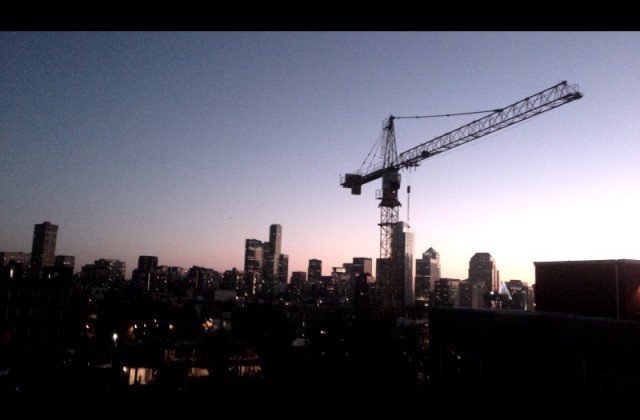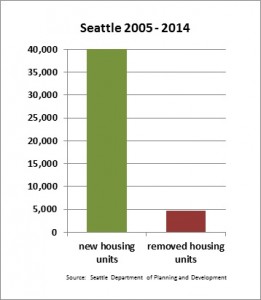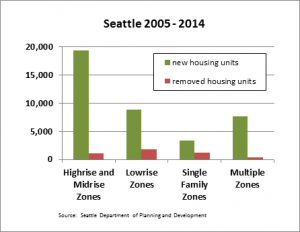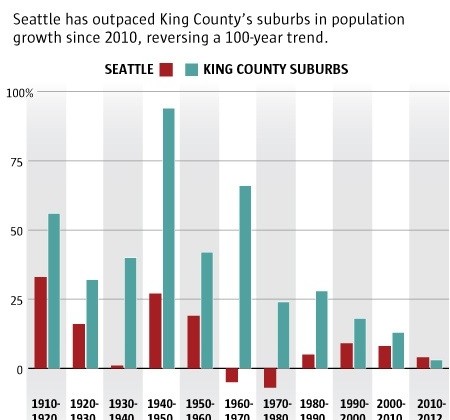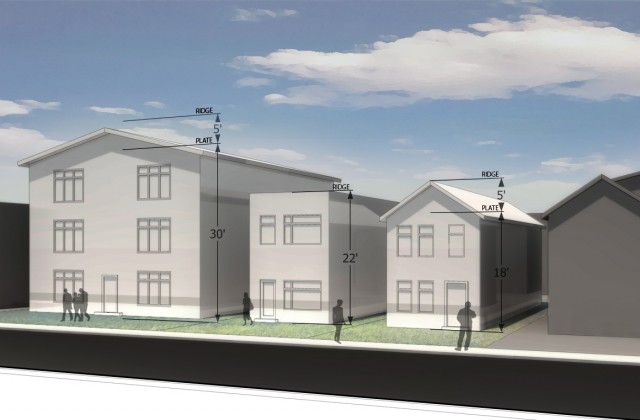Out With (A Few of) the Old, In With (Lots of) the New
This week I was on KING 5 News pushing back on the idea that a moratorium on new housing would actually help prices in Seattle. I said what we’ve been saying over and over, slowing the construction of new housing is a recipe for scarcity, and scarcity means higher prices. People love our city and they want to work and live here now more than ever and that is a great thing.
But some people in Seattle want to shut the door to new jobs and new housing in the name of “saving” existing affordable housing. Here’s what Jon Fox said in a recent editorial in Real Change. He wants the City Council and Mayor to:
Establish a moratorium on issuing residential construction permits in all neighborhoods where rates of growth already exceed levels needed to meet their 2024 regional growth targets.
and
Require any developer tearing down low-income housing to replace those units one-for-one, and give low-income tenants the first right to purchase their apartments before they’re sold to developers.
Listening to Fox and his allies like Councilmember Kshama Sawant one would think that new growth going on in Seattle had wiped out a lot of existing housing. While it is true that new construction often demolishes existing housing, just how many homes were removed and replaced with new housing?
Here is a chart that shows a comparison of new housing units built compared to units removed from use or demolished (click on chart for larger image).
The story that moratorium advocates tout–that new housing construction comes largely at the expense of existing housing–simply isn’t true. The facts point to a different story; over a decade 40,000 housing units were built while less than 5,000 units were removed from use or demolished. Each one of those housing units has a story, functioning as a home for real people and families. But Seattle has been able to grow and create lots of housing without wiping out large swaths of existing homes.
And where was the growth and the demolition?
Less than half of the new homes were built in highrise and midrise zones (the places where Fox says all the supposed harm is being done) and the high and midrise zones had the fewest existing homes demolished. That’s because that construction often happened on existing parking lots or retail uses.
The lowrise zone saw the most existing housing units removed compared to new units, which shows that much of the growth there did not come at the expense of residual single-family homes in that zone. In single family zones it’s important to note that that growth was more single family homes taking the place of fewer single family homes, and not the result of up zones. It’s also hard to argue that the homes taken down were all “affordable” by the official definition since the removed homes weren’t uniform in their location or type.
And how did Seattle do in creating more affordable units during that same period? In 2012 the City reported
$13.8 million will support eight housing developments with 508 affordable apartments. An additional $3 million was awarded to three previously funded projects for building improvements and to address a financing gap. The eight new projects will result in over $137 million in total capital investment, creating jobs and generating state and local revenues. These projects bring total rental housing production to 1,371 units, well on the way to meeting the Levy’s seven year goal of 1,670 units.
The City’s levy effort alone, over seven years, created 1,371 units; that’s roughly 30 percent of the units removed during a nine year period. This doesn’t include rental assistance and other programs to help offset housing costs for poor people.
When housing prices rise the best thing to do is to build more housing of all kinds in every zone, including more housing for people with less to spend. A moratorium on new housing during the period shown would certainly have “saved” some portion of the 4,727 units removed, but it would have meant tens of thousands of new people would have had no where to live in Seattle. That would have been terrible then, and it doesn’t sound like a good plan for the future either.
Housing Moratorium? Smart Growth Seattle on KING 5
Yesterday evening I appeared on KING 5 TV to refute the idea of a moratorium on growth. The Seattle Community Council Federation had a meeting to plan for a moratorium on all new growth in Seattle.
Representatives of an ad hoc citywide group of community activists [were] on hand to ask for advice and support from the Federation and its member organizations for tough growth controls and developer impact fees and to join at a large planned press event the week prior to the Mayor’s planned neighborhood summit. The goal is to create a unified, simple position across neighborhoods we can all unify around, present it at a press conference and then carry the message to the Mayor’s April neighborhood summit.
The group is determined to crack down on new growth as if it was a crime wave. Here’s how I responded:
Roger Valdez, director of Smart Growth Seattle, says additional growth is needed to drive rent costs down.
“If you think housing is expensive now, wait until you put a moratorium on it,” he said. “If these folks close off the housing supply there is not going to be anywhere for them to live. They are going to have to live outside the city. We think that is unsustainable.”
As I pointed out in a recent blog post, Seattle is growing. That’s a really good thing. The challenge is to provide housing choices to people who want to work and live here. That’s what we’re advocating for. Fortunately, there is a voice now to speak in favor of growth in our city. We have a lot of work ahead to persuade people that more housing, not less, is what will help lower prices.
Seattle Growing Faster than Suburbs
The Seattle Times reports this morning that for the first time in a century the growth trend in our region has changed: more people are moving to Seattle than surrounding towns and cities.
The housing market reflects this trend; more people are seeking jobs in Seattle and also a place to call home.
Signs of Seattle’s success are not difficult to spot. Everywhere you look there seems to be a new apartment building under construction. As reported in The Seattle Times, more apartments were opened in 2013 than in any of the previous 20 years.
And the people needed to fill all those new units are showing up. Seattle gained more than 23,000 residents between 2010 and 2012. Census data show that among the 50 most-populous U.S. cities, Seattle has had the eighth-fastest rate of growth.
This growth is a good thing for the city; it means our economy is getting better. It also means increasing demand for housing. If we don’t build more housing it will become scarce, and scarce housing means higher priced housing. If we allow more housing of all kinds in all neighborhoods, we’ll get stable or even falling prices for housing. If we hesitate and add more fees and process, prices will get higher and the voices demanding more regulation and price controls will get louder.
Ironically it’s that discomfort and those voices the City Council hears from the most as we grow, and those voices often advocate for policies that would make things worse: more limits, process, and fees on new housing.
That’s why as we grow, we should be thinking ahead; we can make things get better or fall behind like San Francisco that is now 100,000 units behind in meeting housing demand. Now that’s uncomfortable and expensive for everyone.
Report: Love Your Neighbor (and Her Home)
This past week the Seattle Times published a guest editorial by Diane Douglas the Executive Director of the Seattle CityClub, headlined, “Seattleites Stop Ignoring Your Neighbors.” The CityClub says it goal is to provide “a space to talk about the issues that impact our lives. Dialogue that is passionately nonpartisan. Connections to leaders and local government. Tools and inspiration to make a difference.” In order to “bridge politics, professions and generations” the organization sponsored a survey to measure Seattle’s Civic Health.
According to Douglas, the report found that Seattle lacks social cohesion. Page 10 of the report quantifies what some have called the “Seattle Freeze” this way:
We rank 48th of 51 comparable communities in the frequency of neighbors talking with neighbors and 37th in neighbors exchanging favors with one another frequently. How can we strengthen greater Seattle’s vibrant civic infrastructure so that everyone is included and the community reaps the benefits of their civic agency?
Douglas suggests that the “Freeze” effect is a real thing, not in your imagination. People really are odd here when it comes to social interaction and engagement. But her editorial and the report go on to say that it actually is a serious problem, making it harder in Seattle to solve some of our serious civic problems. I agree. And that’s true when it comes to housing too, when it becomes acceptable not just to avoid neighbors but call them and where they live names.
Here’s what Douglas suggests as a solution:
Imagine if we could keep the 12th Man spirit going and deepen it to extend to everyone, to other issues, all year round. Imagine if we could hold on to this civic spirit as if it were the force that would catapult us to the next championship. What we’re playing for is not just the Super Bowl championship, but the high stakes championship of our regional prosperity.
True. I think the 12th Man connection is a pretty powerful one, but how about one that is even deeper. Many Episcopal and Roman Catholic Churches had a series of relevant readings this past Sunday including from Leviticus stating what is often called the Golden Rule: “Love your neighbor as yourself.”
Regardless of religious bent or no bent at all, the Golden Rule is one of those inherently sensible normative statements that almost everyone can embrace. If we all treated each other the way we prefer to be treated, the argument goes, most of the world’s great problems would solve themselves.
Whether it’s the 12th Man Spirit or the Golden Rule, Seattle would benefit from a more welcoming atmosphere toward new people and different housing types. So often the discourse gets riddled with references like the one made by Representative Gerry Pollet calling some people’s homes “monstrosities” or Seattle City Councilmember Kshama Sawant saying that living in microhousing is “not humane.” Some people have even blocked buses full of people trying to get to work because they are “yuppies” who are driving up housing prices.
Our elected officials should lead the way by talking about including all the options for Seattle’s housing future. And, in the end, these are neighbors we’re talking about. Buildings matter, but aren’t the people inside them what counts? Calling people’s homes names really isn’t going to get us very far toward finding the 12th Man Spirit or the following the Golden Rule.
And if cohesion helps solve our big problems like creating more housing choices, shouldn’t we love our neighbor’s home as much as our own? What would happen to our housing debate if we talked about making room for new people and jobs rather than fretting over “height, bulk, and scale?” What if we celebrated and welcomed all the new people moving to our region with crazed enthusiasm like we welcomed back the Seahawks?
PLUS Committee Meets Today
Today the Planning Land Use and Sustainability (PLUS) Committee meets at 2PM. Today’s meeting includes an update on small-lot legislation. The PLUS Committee will be hearing and update from Department of Planning and Development staff on small-lot legislation. No action will be taken but this will be the first time in almost a year that small-lot legislation will be discussed in the Committee. The agenda for the meeting is below. Look for updates on Facebook.
SEATTLE CITY COUNCIL
PLANNING, LAND USE, AND SUSTAINABILITY COMMITTEE*
AGENDA
Friday, February 21, 2014
2:00 p.m.
Members:
Mike O’Brien, Chair
Tim Burgess, Vice Chair
Nick Licata, Member
Sally J. Clark, Alternate
Staff:
Josh Fogt, Legislative Assistant
Esther Handy, Legislative Assistant
Rashad Morris, Legislative Assistant
Location:
Council Chambers, City Hall
600 Fourth Avenue
Seattle, WA 98104
Committee Chair
Telephone: 206-684-8800
Email
Homepage
Video Archive
Council Meeting Listen Line:206-684-8566
*This meeting also constitutes a meeting of the Full Council, provided that the meeting shall be conducted as a committee meeting under the Council Rules and Procedures, and Council action shall be limited to committee business.
Please Note: Time listed are estimated.
A. Call to Order
B. Quasi-Judicial Matter
1. C.F. 312973
Application of Midtown Limited Partnership to rezone land located at 2301 East Union Street from Neighborhood Commercial 2 with a 40 foot height limit (NC2-40) and Neighborhood Commercial 2 with a 40 foot height limit and pedestrian zone designation (NC2P-40) to Neighborhood Commercial 2 with a 65 foot height limit and pedestrian zone designation (NC2P-65) (Project Nu mber 3005931, Type IV).
BRIEFING AND DISCUSSION (30 minutes)
Presenter: Martha Lester, Council Central Staff
Supporting Documents:
a. Central Staff Memo
b. Department of Planning and Development (DPD) Analysis and Recommendations
c. Written Public Comments
d. Hearing Examiner Findings and Recommendations
e. Applicant’s Appeal
f. DPD Response to Appeal
C. Public Comment
D. Other Items of Business
2. Extension of Interim Small Lot Regulations
BRIEFING AND DISCUSSION (15 minutes)
Presenters: Andy McKim and Mike Podowski, Department of Planning and Development (DPD); Ketil Freeman, Council Central Staff
Supporting Documents:
a. Draft Proposed Interim Extension Bill
b. Central Staff Memo on Extension Bill
3. Long-Term Regulation of Small Lots
BRIEFING AND DISCUSSION (15 minutes)
Presenters: Andy McKim and Mike Podowski, DPD; Ketil Freeman, Council Central Staff
Supporting Document:
a. DPD Recommendations for Small Lot Regulation
Related to petroleum transport by rail through Seattle and the State of Washington; urging adoption of state legislation and federal regulations; state assessment of risks; railroad company restriction of petroleum transport through Seattle; and update of City incident response plans to address the potential safety, environmental, and economic impacts of petroleum transport by rail.
DISCUSSION AND POSSIBLE VOTE (30 minutes)
Presenters: Eric de Place, Sightline Institute; Rebecca Ponzio, Washington Environmental Council; Captain J. Havner, Seattle Fire Department; Tracy Morgenstern, Office of Sustainability and Environment
Supporting Document:
a. The Northwest’s Pipeline on Rails Presentation
E. Adjournment
